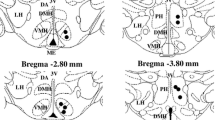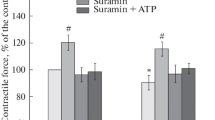Summary
In rats kept under ordinary laboratory and living conditions the intravenous injection of eserine regularly produced a dose-dependent hypothermic effect. Neostigmine produced variable responses including both hyperthermia and hypothermia. The effect of eserine is most probably due to an activation of central cholinergic processes. The finding that the hypothermic effect of eserine was blocked by atropine and not by methylatropine indicates both the central origin of the effect and the implication of muscarinic receptors in it. Propranolol did not affect the response to eserine, but alpha-receptor blocking agents (phenoxybenzamine, phentolamine), if injected in sufficiently high doses, blocked it. All the adrenergic blockers, particularly the alpha-receptor blockers, were found to produce pronounced hypothermia by themselves.
Eserine was also found to produce a dose-dependent decrease in the oxygen consumption. This effect is most probably crucial for the hypothermic response to eserine, because this substance also produced hypothermia at ambient temperatures close to thermal neutrality. It is supposed that eserine, by activating central cholinergic synapses, produces an inhibition of thermogenesis. In animals kept in cages with warm bases (29–37‡C) eserine produced hyperthermia. This effect was blocked by neither propranolol nor atropine, and it is most probably produced by fasciculations.
Similar content being viewed by others
References
Bligh, J., Cottle, W. H.: The influence of ambient temperature on thermoregulatory responses to intraventricularly injected monoamines in sheep, goats and rabbits. Experientia (Basel)25, 608–609 (1969).
—, Maskrey, M.: A possible role of acetylcholine in the central control of body temperature in sheep. J. Physiol. (Lond.)203, 55–57 P (1969).
——: The interactions between the effects on thermoregulation of TAB vaccine injected intravenously and monoamines injected into a lateral cerebral ventricle of the Welsh Mountain Sheep. J. Physiol. (Lond.)213, 60–62 P (1971).
Corrodi, H., Fuxe, K., Hökfelt, T.: A possible role played by central monoamine neurons in thermoregulation. Acta physiol. scand.71, 224–232 (1967).
Cox, B., Potkonjak, D.: The effect of ambient temperature on the actions of tremorine on body temperature and on the concentration of noradrenaline, dopamine, 5-hydroxytryptamine and acetylcholine in rat brain. Brit. J. Pharmacol.31, 356–366 (1967).
Curtis, D. R., Koizumi, K.: Chemical transmitter substances in the brain stem of the cat. J. Neurophysiol.24, 80–90 (1961).
Feldberg, W., Lotti, V. J.: Temperature response to monoamines and an inhibitor of MAO injected into the cerebral ventricles of cats Brit. J. Pharmacol.31, 152–161 (1967).
Friedman, M. J., Jaffe, J. H., A central hypothermic response to pilocarpine in the mouse. J. Pharmacol, exp. Ther.167, 34–44 (1969).
Gelineo, S.: Influence du milieu thermique d'adaptation sur la thermogenése. Ann. Physiol. Physicochim. Biol.10, 1083–1115 (1934).
—: Organ systems in adaptation-the temperature regulation system. Handbook of Physiology-Environment, Am. Physiol. Soc. vol. 15, pp. 259–282 (1959).
Giaja, I.: Hypothermie, hibernation et poikilothermie experimentale. Biol. Med.42, 1–36 (1953).
Gordon, R., Spector, S., Sjoerdsma, A., Udenfriend, S.: Increased synthesis of norepinephrine and epinephrine in the intact rat during exercise and exposure to cold. J. Pharmacol, exp. Ther.153, 440–447 (1966).
Hess, M. E., Shanfeld, J., Haugaard, N.: The role of the autonomic nervous system in the regulation of heart phosphorylase in the open-chest rat. J. Pharmacol. exp. Ther.135, 191–196 (1962).
Kirkpatrick, W. E., Jenden, D. J., Lomax, P.: The effect of N-4-diethylamino-2-butynyl-succinimide (DKJ 21) on oxotremorine induced hypothermia in the rat. Int. J. Neuropharmacol.6, 273–277 (1967).
—, Lomax, P.: The effect of atropine on the body temperature of the rat following systemic and intracerebral injection. Life Sci.6, 2273–2278 (1967).
——, Jenden, D. J.: Iontophoretic application of acetylcholine to thermoregulatory centers of rats. Proc. West. Pharmacol. Soc.12, 72–75 (1969).
Lomax, P., Foster, R. S., Kirkpatrick, W. E.: Cholinergic and adrenergic interactions in the thermoregulatory centers of the rat. Brain Res.15, 431–438 (1969).
—, Jenden, D. J.: Hypothermia following systematic and intracerebral injection of oxotremorine in the rat. Int. J. Neuropharmacol.5, 353–359 (1966).
Meeter, E.: The mode of action of cholinesterase inhibitors on the temperature regulation of the rat. Arch. int. Pharmacodyn.182, 416–419 (1969).
Mršulja, B., Terzić, M., Varagić, V. M.: The effect of physostigmine and neostigmine on the concentration of glycogen in verious brain structures of the rat. J. Neurochem.15, 1329–1333 (1968).
Myers, R. D.: Temperature regulation -neurochemical systems in the hypothalamus. In: The hypothalamus-anatomical, functional and clinical aspects, pp. 506–523. Springfield, Ill.: Ch. C. Thomas 1969.
—: The role of hypothalamic transmitter factors in the control of body temperature. In: J. D. Hardy: Physiological and behavioural regulation, pp. 648–566. Springfield, Ill.: Ch. C. Thomas 1970.
—, Yash, T. L.: Feeding and temperature responses in the unrestrained rat after injections of cholinergic and aminergic substances into the cerebral ventricles. Physiol. Behav.3, 917–928 (1968).
Simmonds, M. A.: Effect of environmental temperature on the turnover of noradrenaline in hypothalamus and other areas of rat brain. J. Physiol. (Lond.)203, 199–210 (1969).
—, Uretsky, N. J.: Central effects of 6-hydroxydopamine on the body temperature of the rat. Brit. J. Pharmacol.40, 630–638 (1970).
Stamenović, B. A., Varagić, V. M.: The effect of eserine on the efferent neuronal activity in the cervical sympathetic of the rat. Neuropharmacology9, 561–566 (1970).
Varagić, V.: The action of eserine on the blood pressure of the rat. Brit. J. Pharmacol.10, 349–353 (1955).
—, KaŽić, T., Rosić, N.: Inversion of physostigmine hypertension by paraoxone and DFP. Iugoslav. Physiol. Pharmacol. Acta4, Suppl.1, 113–120 (1968).
—, Terzić, M., Mršulja, B. B.: The effect of physostigmine and neostigmine on the concentration of glycogen in the liver of the rat. Naunyn-Schmiederbegs Arch. Pharmak. exp. Path.258, 229–237 (1967).
Author information
Authors and Affiliations
Additional information
One of the authors (V.M.V.) wishes to thank the Wellcome Trust for a grant which provided part of the equipment used in these experiments. This work was also supported by a research grant from ZMNU.
Rights and permissions
About this article
Cite this article
Varagić, V.M., Žugić, M. & KaŽić, T. The hypothermic effect of eserine in the rat. Naunyn-Schmiedebergs Arch. Pharmak. 270, 407–418 (1971). https://doi.org/10.1007/BF01002351
Received:
Issue Date:
DOI: https://doi.org/10.1007/BF01002351




